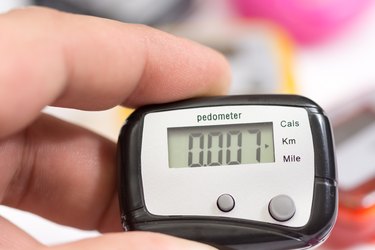
A pedometer is an inexpensive mechanical device that may help you improve your level of fitness.The National Health and Nutrition Examination Survey found over 66 percent of Americans have overweight or obesity.
Whether you struggle with your weight or desire to maintain your weight, using a simple pedometer may help you stay fit. When using a pedometer, place the pedometer in the correct position to accurately measure the number of steps you take each day.
Video of the Day
Video of the Day
Benefits
Wearing a pedometer in the proper location helps you accurately monitor the number of steps you take. An improperly positioned pedometer may miss or add steps, giving you a false reading. If the reading is too high due to improper placement, you may not challenge yourself to add more steps to your day due to the false reading. Conversely, if improper placement causes you to record too few steps, you may become discouraged by your apparent lack of progress and stop trying to increase your activity level. Check your pedometer placement frequently throughout the day.
Barriers and Types
You can buy pedometers in several styles. The most common style of pedometer is the type that you attach to either your waistband or belt. You can often find this type of pedometer in discount stores, sporting stores or even drug stores for under $20.00. Another style has a clip attached, giving you the opportunity to either attach it to your waistband or drop it in your purse or briefcase. Although body fat and clothing may make it difficult to attach a waistband style to your waist, avoid clipping the pedometer to your bra strap or shoe, as those locations are not as accurate, according to Catherine Ling and Sheila Smith, authors of a 2010 study published in the "Journal of the Academy of Nurse Practitioners."
Waistband Attachment
When using a pedometer that must be physically attached to your body, read the directions. Most pedometers need to be several inches from your center body or directly in line with your knee to accurately record the number of steps you take each day. The pedometers work by using a pendulum which moves the counter as you move forward or backward, according to the University of Missouri Extension. Use the provided clip attachment to secure the pedometer to your waistband or belt. Walk for about 20 steps, stop and check the pedometer for accuracy. Adjust it closer or farther to your naval until the counter is accurate. If you have a large abdomen, secure the pedometer to the back of your waistband and recount your steps.
Purse or Pocket Use
If you select a pedometer that gives you the option of carrying it or wearing it, place it in your purse, pocket or briefcase. Placing it in such a location is convenient if your outfit makes it difficult to conceal the pedometer under a jacket or shirt. As with a clip pedometer, check the accuracy of measurement by counting off at least 20 steps and reading the pedometer display. Try clipping the pedometer to the inside of your pocket or to a inside compartment of your purse or briefcase if simply placing it in the bottom of your pocket or purse does not give you an accurate reading.
Considerations
If you are not physically active, begin using your pedometer as a means of establishing your base number of steps. Recording your total steps you take each day for two days. If you walk 3,000 steps a day, set of goal of increasing the number of steps you take by 10 to 15 percent each week. Gradual increases will make it less likely for you to experience injury. Although 10,000 steps is the common recommendation, a publication by the President's Council on Physical Fitness and Sports indicates that you should increase the number of steps you take in relation to your current health, as chronic diseases or age may make it difficult to reach a set number of steps each day.
- Weight-Control Information Network: Overweight and Obesity
- University of California Santa Barbara: Pedometer Information
- Wiley Online Library: Alternative Placements for Women Wearing Pedometers
- University of Missouri Extension: Walk Well
- United States Department of Veterans Affairs: HealthPOWER! Prevention News (Summer 2010) NCP News
- President's Council on Physical Fitness and Sports: Taking Steps Toward Increased Physical Activity: Using Pedometers to Measure and Motivate
- USA Today: Brisk Walking Brings Better Health, Less Body Fat